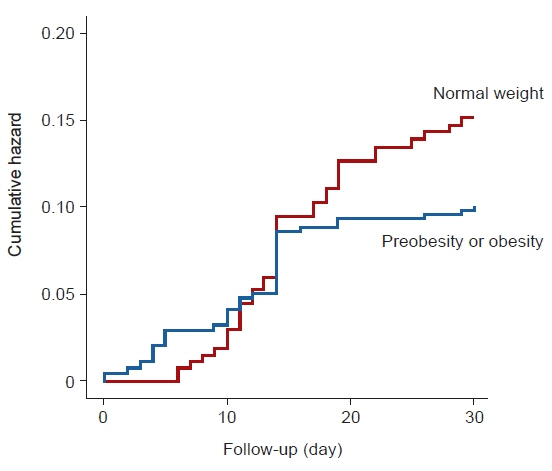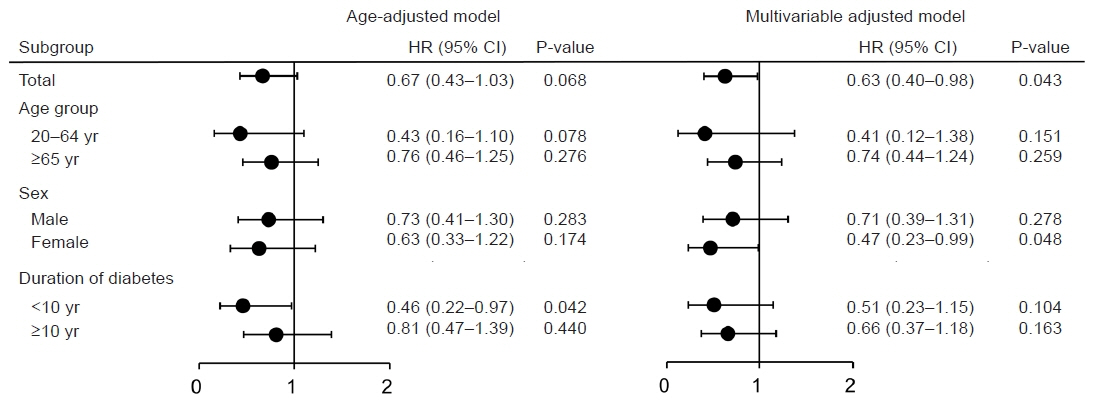Cardiovasc Prev Pharmacother.
2023 Jul;5(3):74-80. 10.36011/cpp.2023.5.e10.
Obesity and 30-day case fatality after hyperglycemic crisis hospitalizations in Korea: a national cohort study
- Affiliations
-
- 1Ajou University Hospital, Suwon, Korea
- 2Division of Endocrinology and Metabolism, Department of Internal Medicine, National Health Insurance Service Ilsan Hospital, Goyang, Korea
- 3Department of Endocrinology and Metabolism, Ajou University School of Medicine, Suwon, Korea
- KMID: 2544630
- DOI: http://doi.org/10.36011/cpp.2023.5.e10
Abstract
- Background
We determined the case fatality rate associated with hospitalization due to hyperglycemic crises and investigated the relationship between obesity status and case fatality for hyperglycemic crises.
Methods
From the Korean National Health Insurance Service-National Sample Cohort, 729 adults who visited the emergency room or were hospitalized due to hyperglycemic crises between January 1, 2010, and December 31, 2019, were included. Preobesity or obesity was defined as a body mass index ≥23.0 kg/m2. Case fatality rates are presented as the proportion of adults who died within 30 days of hospitalization. Cox proportional hazards models were used to estimate hazard ratios (HRs) and 95% confidence intervals (CIs) for 30-day fatalities according to preobesity or obesity status.
Results
The 30-day case fatality rate for hyperglycemic crises was 11.2%. In those aged ≥65 years, the fatality rate was twice as high as that in those aged 20 to 64 years (13.8% vs. 6.8%). Adults with preobesity or obesity had a lower fatality rate than those with normal weight (9.5% vs. 14.0%). After adjustment for confounding variables, preobesity or obesity was found to be significantly associated with a decreased risk for 30-day case fatality compared to normal weight (HR, 0.63; 95% CI, 0.40–0.98).
Conclusions
In Korea, hyperglycemic crises had a high fatality rate. Management needs to be improved to prevent hyperglycemic crises and reduce mortality.
Keyword
Figure
Reference
-
1. You JH, Song SO, Park SH, Park KH, Nam JY, Kim DW, et al. Trends in hyperglycemic crisis hospitalizations and in- and out-of-hospital mortality in the last decade based on Korean National Health Insurance Claims Data. Endocrinol Metab (Seoul). 2019; 34:275–81.2. Kim RB, Kim HS, Kang DR, Choi JY, Choi NC, Hwang S, et al. The trend in incidence and case-fatality of hospitalized acute myocardial infarction patients in Korea, 2007 to 2016. J Korean Med Sci. 2019; 34:e322.3. Piche ME, Tchernof A, Despres JP. Obesity phenotypes, diabetes, and cardiovascular diseases. Circ Res. 2020; 126:1477–500.4. Elagizi A, Kachur S, Lavie CJ, Carbone S, Pandey A, Ortega FB, et al. An overview and update on obesity and the obesity paradox in cardiovascular diseases. Prog Cardiovasc Dis. 2018; 61:142–50.5. Lee DH, Ha KH, Kim HC, Kim DJ. Association of body mass index with risk of major adverse cardiovascular events and mortality in people with diabetes. J Obes Metab Syndr. 2018; 27:61–70.6. Lee J, Lee JS, Park SH, Shin SA, Kim K. Cohort profile: the National Health Insurance Service-National Sample Cohort (NHIS-NSC), South Korea. Int J Epidemiol. 2017; 46:e15.7. Kim BY, Kang SM, Kang JH, Kang SY, Kim KK, Kim KB, et al. 2020 Korean Society for the Study of Obesity Guidelines for the Management of Obesity in Korea. J Obes Metab Syndr. 2021; 30:81–92.8. Benoit SR, Zhang Y, Geiss LS, Gregg EW, Albright A. Trends in diabetic ketoacidosis hospitalizations and in-hospital mortality: United States, 2000-2014. MMWR Morb Mortal Wkly Rep. 2018; 67:362–5.9. Malone ML, Gennis V, Goodwin JS. Characteristics of diabetic ketoacidosis in older versus younger adults. J Am Geriatr Soc. 1992; 40:1100–4.10. Graves EJ, Gillum BS. Detailed diagnoses and procedures, National Hospital Discharge Survey, 1995. Vital Health Stat 13. 1997; (130):1–146.11. Lorber D. Nonketotic hypertonicity in diabetes mellitus. Med Clin North Am. 1995; 79:39–52.12. Chen HF, Wang CY, Lee HY, See TT, Chen MH, Jiang JY, et al. Short-term case fatality rate and associated factors among inpatients with diabetic ketoacidosis and hyperglycemic hyperosmolar state: a hospital-based analysis over a 15-year period. Intern Med. 2010; 49:729–37.13. Kitabchi AE, Umpierrez GE, Miles JM, Fisher JN. Hyperglycemic crises in adult patients with diabetes. Diabetes Care. 2009; 32:1335–43.14. Huang CC, Kuo SC, Chien TW, Lin HJ, Guo HR, Chen WL, et al. Predicting the hyperglycemic crisis death (PHD) score: a new decision rule for emergency and critical care. Am J Emerg Med. 2013; 31:830–4.15. Han SJ, Boyko EJ. The evidence for an obesity paradox in type 2 diabetes mellitus. Diabetes Metab J. 2018; 42:179–87.16. Carnethon MR, De Chavez PJ, Biggs ML, Lewis CE, Pankow JS, Bertoni AG, et al. Association of weight status with mortality in adults with incident diabetes. JAMA. 2012; 308:581–90.17. Davenport DL, Xenos ES, Hosokawa P, Radford J, Henderson WG, Endean ED. The influence of body mass index obesity status on vascular surgery 30-day morbidity and mortality. J Vasc Surg. 2009; 49:140–7.18. Karampela I, Chrysanthopoulou E, Christodoulatos GS, Dalamaga M. Is there an obesity paradox in critical illness? Epidemiologic and metabolic considerations. Curr Obes Rep. 2020; 9:231–44.
- Full Text Links
- Actions
-
Cited
- CITED
-
- Close
- Share
- Similar articles
-
- Trends in Hyperglycemic Crisis Hospitalizations and in- and out-of-Hospital Mortality in the Last Decade Based on Korean National Health Insurance Claims Data
- Response: Trends in Hyperglycemic Crisis Hospitalizations and in- and out-of-Hospital Mortality in the Last Decade Based on Korean National Health Insurance Claims Data (Endocrinol Metab 2019;34:275–81, Ji Hong You et al.)
- Letter: Trends in Hyperglycemic Crisis Hospitalizations and in- and out-of-Hospital Mortality in the Last Decade Based on Korean National Health Insurance Claims Data (Endocrinol Metab 2019;34:275–81, Ji Hong You et al.)
- The Conundrum of Obesity and Gastroparesis Hospitalizations: A Retrospective Comparative Analysis of Hospitalization Characteristics and Disparities Amongst Socioeconomic and Racial Backgrounds in the United States
- A nationwide analysis on the influence of obesity in inflammatory bowel disease hospitalizations




